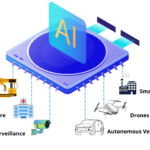With AR, the user has the ability to dictate the real world. On the other hand, VR users are restrained by the system’s creations.
Augmented reality and virtual reality are reality technologies that either enhance or replace a real-life environment with a simulated one.
- Augmented reality (AR) augments your surroundings by adding digital elements to a live view, often by using the camera on a smartphone.
- Virtual reality (VR) is a completely immersive experience that replaces a real-life environment with a simulated one.
With rapid advances in high-speed communication and computation, augmented reality (AR) and virtual reality (VR) are emerging as next-generation display platforms for deeper human-digital interactions. Nonetheless, to simultaneously match the exceptional performance of human vision and keep the near-eye display module compact and lightweight imposes unprecedented challenges on optical engineering.
What is the difference between AR & VR?
While the terms ‘augmented reality’ (AR) and ‘virtual reality’ (VR) are sometimes used interchangeably, there are important distinctions to make between these two very different technological advancements.
Augmented reality or AR creates a simulated environment by blending digital elements within a real-world environment. AR apps help bring predefined elements into the world to show a different reality.
The purpose of AR is to augment the environment and let virtual elements interact with real objects to create intended meanings. In AR, informatively designed virtual environments coexist with the real ones by providing additional data about the real world.
On the contrary, Virtual reality or VR is a simulation of the world or an alternate reality. Its most common and recognised application is through video games and 3D movies. VR helps in creating a lifelike and immersive experience so that the user becomes a part of this new simulation instead of merely being a spectator. It uses sensory devices and touchpoints to simulate the senses such as VR headsets and haptic gloves.
The purpose of VR is to create an illusion of immersion in a life-size 3D digital environment. To make 3D images and videos, much of which reproduce the real or imaginary world, VR systems usually use computer vision and advanced graphics that add depth and reconstruct the scale and distance between static two-dimensional (2D) images.
All this together is designed to replace a real-life environment with a simulated one, creating an immersive effect that feels like you are part of the computer-generated digital environment that you are viewing.
What industries are using these technologies?
Today, AR technology is commonly complemented by mobile phone technologies such as GPS, 3G, 4G and remote sensing. The combined image is usually projected onto mobile screens, augmented reality glasses and other devices.
AR and VR products are being used to solve the “Skills Gap” problem. This problem occurs when skilled workers retire, and with them, their skilled knowledge they have gained. This knowledge needs to be transferred to new workers. Furthermore, they can annotate the real world with technical specifications to aid the worker.
AR/VR in Education
AR/VR in higher education has the potential to transform learning opportunities in the classroom and improve student outcomes – all while creatively engaging and preparing students for new opportunities.
Doctors and healthcare specialists also benefit from VR and AR technologies by using them in operating rooms and classrooms. For example, before performing an operation, surgeons can use VR and AR technologies to walk through the organs they need to operate or view 3-D models of challenging surgical cases. Moreover, 3-D organ models can be used for illustrative purposes at conferences, in the learning process, or to explain to patients what’s going to happen during the surgery and what will be the outcomes.
AR and VR helps in maintenance of manufacturing equipment. For example, Mitsubishi electric has been developing a 3D model that enables users to confirm the order of inspection on an AR display and then enter inspection results with their voice. This includes inspections of water treatment plants and building electrical systems. The engineer can see a machine’s status simply by glancing at it through an augmented reality display.
Role of virtual reality and augmented reality in the metaverse
The metaverse refers to a simulated digital environment that combines multiple elements of technology, such as AR, VR, MR and blockchain, along with social media concepts to create spaces that enrich users’ interaction by mimicking the real world.
As a shared 3D virtual space with online infrastructure and real-time events, and with ever-evolving aspects which are collectively shared by its inhabitants, the metaverse is expected to change the way people interact with each other, connecting the virtual and physical worlds.
The real and virtual are merged in the metaverse using AR and VR technologies, which play a key role in the metaverse’s formation. Augmented reality technology allows for embedding 3D visualizations into the real physical world and offers real-time interaction.
VR is seen as an integral component of the new metaverse ecosystem, providing an immersive experience for users in a dynamic 3D virtual environment. The metaverse is something users could leap into (via VR) or deliver to users’ reality (via AR).







